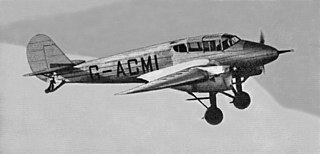
The Dornier Do 12 Libelle III was the third of a line of small German flying boats of the 1930s. It started with the Dornier A Libelle I and the Dornier A Libelle II, though the Do 12 was not a continuation, but an entirely new aircraft.

The Auster B8 Agricola was a commercially unsuccessful British agricultural aircraft designed for the aerial topdressing market which opened up in New Zealand in the early 1950s.

The Miles M.38 Messenger is a British four-seat liaison and private owner aircraft built by Miles Aircraft.

The Blackburn B-1 Segrave was a 1930s British twin-engine four-seat touring aircraft built by Blackburn Aircraft.

The de Havilland DH.50 was a 1920s British large single-engined biplane transport built by de Havilland at Stag Lane Aerodrome, Edgware, and licence-built in Australia, Belgium, and Czechoslovakia.

The Auster J/2 Arrow is a 1940s British single-engined two-seat high-wing touring monoplane built by Auster Aircraft Limited at Rearsby, Leicestershire, England.

The ANEC I and ANEC II were 1920s British single-engine ultralight aircraft designed and built by Air Navigation and Engineering Company Limited at Addlestone Surrey. One was privately constructed in Brisbane, Australia.
Air Navigation and Engineering Company Limited was a British aircraft manufacturer from its formation in 1919 to 1927.

The B.A. Eagle was a light aircraft manufactured in the United Kingdom during the 1930s. It was a three-seat low-wing monoplane built by the "British Klemm Aeroplane Company" Production was limited, with 43 aircraft built.
The Larkin Aircraft Supply Company (Lasco) was an Australian aircraft manufacturer based at Coode Island in Melbourne.

The PZL-102 Kos (blackbird) is a Polish two-seat touring and training monoplane designed and built by PZL.
The Lasco Lascoter was a 1920s Australian 6-seat passenger and mail carrier aircraft built by the Larkin Aircraft Supply Company (Lasco) at Coode Island, Victoria. It was the first Australian-designed and built airliner to be granted a Certificate of Airworthiness.

The Sablatnig P.III was an airliner produced in Germany in the early 1920s.

The Handasyde monoplane was a single-seat light aircraft built for the 1923 Lympne motor glider competition. It competed there but won no prizes.
The British Aircraft Cupid was a two-seat, single-engined monoplane, a smaller version of the B.A. Eagle designed for touring and training. Only one was built.
The Lasco Lascondor was a 1930s Australian 8-seat passenger and mail carrier aircraft built by the Larkin Aircraft Supply Company (Lasco) at Coode Island, Victoria. It is claimed to be the first multi-engined aircraft designed and built in the Southern Hemisphere.

The Comte AC-12 Moskito was a 1930s Swiss three-seat light touring cabin monoplane produced by Flugzeugbau A. Comte.

The CASA III was a 1920s Spanish two-seat monoplane, designed by Luis Sousa Peco and built by Construcciones Aeronáuticas SA (CASA) at Getafe near Madrid.

The Martin Handasyde No.3 was an early British single-seat monoplane design, built in partnership by H.P. Martin and George Handasyde. Only one was built.

The Handasyde H.2 was a six seat airliner built in the UK in the early 1920s. Only one was completed.
















